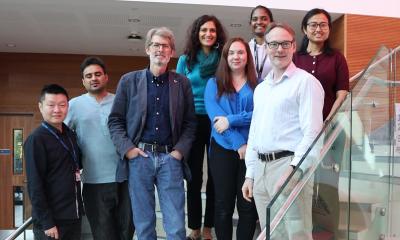- Novavax has successfully achieved U.S. BLA approval and completed both EU and U.S. marketing authorization transfers for Nuvaxovid™ to Sanofi in line with its CLA and its corporate strategy, securing a total of $225 million in non-dilutive capital year-to-date 2025
GAITHERSBURG, Md., Nov. 4, 2025 /PRNewswire/ -- Novavax, Inc. (Nasdaq: NVAX) has completed the transfer of the U.S. marketing authorization for its COVID-19 vaccine, Nuvaxovid™ to Sanofi, enabling Sanofi to take full responsibility for commercial and regulatory activities in the U.S. and fulfilling part of its collaboration and license agreement (CLA). The transfer triggered the second of two $25 million marketing authorization transfer milestone payments to Novavax, following the European Union (EU) transfer completed in October 2025.
"With the successful achievement of our BLA approval and completion of both U.S. and EU marketing authorization transfers for Nuvaxovid™ to Sanofi, we have delivered on our partnership agreement and secured $225 million in additional milestone revenue to date," said John C. Jacobs, President and Chief Executive Officer, Novavax. "We look forward to Sanofi's success in globally marketing our protein-based, non-mRNA COVID-19 vaccine in the years to come."
Novavax is eligible to receive additional future milestones and royalties under the CLA related to Nuvaxovid, combination products developed by Sanofi using Nuvaxovid and new vaccines created by Sanofi utilizing Novavax's Matrix-M® adjuvant.
VACCINE AUTHORIZATION (U.S.)
Nuvaxovid is a vaccine indicated for active immunization to prevent COVID-19 caused by SARS-CoV-2 in individuals 65 years of age and older, or 12 years through 64 years of age with at least one underlying condition that puts them at high risk for severe outcomes from COVID-19.
IMPORTANT SAFETY INFORMATION
Contraindications
- Do not administer Nuvaxovid to individuals with a known history of severe allergic reaction (e.g., anaphylaxis) to any component of Nuvaxovid or to individuals who had a severe allergic reaction (e.g., anaphylaxis) following a previous dose of Novavax COVID-19 Vaccine, Adjuvanted.
Warnings and Precautions
- Management of Acute Allergic Reactions: Appropriate medical treatment must be immediately available to manage potential anaphylactic reactions following administration of Nuvaxovid.
- Myocarditis and Pericarditis: Clinical trials data provide evidence for increased risks of myocarditis and pericarditis following administration of Nuvaxovid. There have been post-marketing reports of myocarditis and pericarditis following administration of Nuvaxovid. The Centers for Disease Control and Prevention has published considerations related to myocarditis and pericarditis after vaccination, including for vaccination of individuals with a history of myocarditis or pericarditis(https://www.cdc.gov/vaccines/covid-19/clinical-considerations/myocarditis.html).
- Syncope (fainting): Syncope (fainting) may occur in association with administration of injectable vaccines, including Nuvaxovid. Procedures should be in place to avoid injury from fainting.
- Altered Immunocompetence: Immunocompromised persons, including individuals receiving immunosuppressive therapy, may have a diminished immune response to Nuvaxovid.
- Limitations of Vaccine Effectiveness: Nuvaxovid may not protect all vaccine recipients.
Adverse Reactions
The most commonly reported (>10%) solicited adverse reactions were injection site tenderness, injection site pain, injection site redness, headache, muscle pain, fatigue, malaise, joint pain, fever and nausea/vomiting.
To report suspected adverse reactions, contact Novavax, Inc. at 1-844-668-2829 or the Vaccine Adverse Event Reporting System (VAERS) at 1-800-822-7967 or https://vaers.hhs.gov.
About Novavax
Novavax, Inc. (Nasdaq: NVAX) tackles some of the world's most pressing health challenges with its scientific expertise in vaccines and its proven technology platform, including protein-based nanoparticles and its Matrix-M adjuvant. The Company's growth strategy seeks to optimize its existing partnerships and expand access to its proven technology platform via research and development innovation, organic portfolio expansion in infectious disease and beyond, and forging new partnerships and collaborations with other companies. Please visit novavax.com and LinkedIn for more information.
Forward-Looking Statements
Statements herein relating to the future of Novavax, its operating plans and prospects, the possible achievement of additional milestones or receipt of milestone payments or royalties under the CLA, future marketing initiatives and the potential development and commercialization of Sanofi combination products, and efforts to pursue additional partnerships, are forward-looking statements. Novavax cautions that these forward-looking statements are subject to numerous risks and uncertainties that could cause actual results to differ materially from those expressed or implied by such statements. These risks and uncertainties include, without limitation, challenges related to Novavax's partnership with Sanofi and in pursuing additional partnership opportunities; challenges satisfying, alone or together with partners, various safety, efficacy and product characterization requirements, including those related to process qualification and assay validation, necessary to satisfy applicable regulatory authorities; difficulty obtaining scarce raw materials and supplies; resource constraints, including human capital and manufacturing capacity, on the ability of Novavax to pursue planned regulatory pathways; challenges or delays in obtaining regulatory authorization for future COVID-19 variant strain changes; challenges or delays in clinical trials; manufacturing, distribution or export delays or challenges; Novavax's exclusive dependence on Serum Institute of India Pvt. Ltd. for co-formulation and filling and the impact of any delays or disruptions in their operations on the delivery of customer orders; and those other risk factors identified in the "Risk Factors" and "Management's Discussion and Analysis of Financial Condition and Results of Operations" sections of Novavax's Annual Report on Form 10-K for the year ended December 31, 2024, and subsequent Quarterly Reports on Form 10-Q, as filed with the Securities and Exchange Commission (SEC). We caution investors not to place considerable reliance on forward-looking statements contained in this press release. You are encouraged to read our filings with the SEC, available at www.sec.gov and www.novavax.com, for a discussion of these and other risks and uncertainties. The forward-looking statements in this press release speak only as of the date of this document, and we undertake no obligation to update or revise any of the statements. Our business is subject to substantial risks and uncertainties, including those referenced above. Investors, potential investors, and others should give careful consideration to these risks and uncertainties.
Contacts:
Investors
Luis Sanay, CFA
240-268-2022
[email protected]
Media
Yvonne Sprow
240-720-7804
[email protected]
SOURCE Novavax, Inc.









